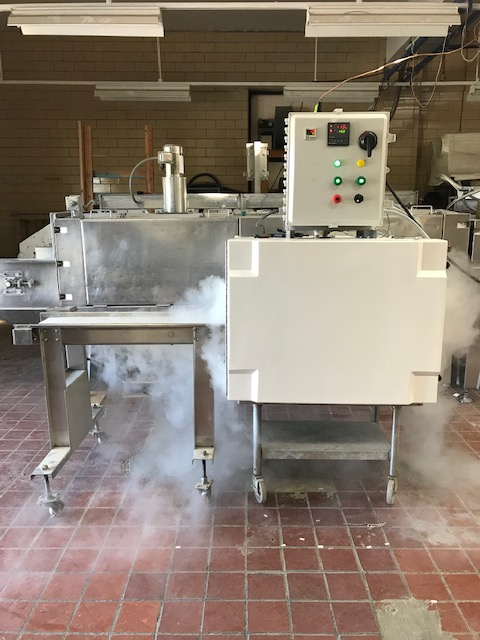As the hot summer fast approaches, Union Kitchen has some chilling news to report. We’re getting a tunnel freezer! Hurray! This guide covers how tunnel freezers allow frozen food manufacturers to more efficiently freeze and store food.
The Science of Quick Freezing
In a previous resource guide, we talked about the safety importance of freezing food. Without proper care, your food is prone to being overrun by spoilage-causing enzymes and organisms. These organisms and enzymes thrive in what is known as the danger zone, temperatures between 40°F to 140°F. Over a period of time, depending on the type of food, this will cause your food to spoil and become unsafe to eat. We’ve all seen bananas go from ripe to rotten in a relatively quick time. Luckily, freezing reduces the risk of this by inactivating the bacteria and enzymes and slowing their growth. But, freezing can be a double-edged sword.
As food slowly freezes, the water within the food begins to freeze and crystalize. This is fine until these crystals start expanding into the food. The expanding crystals penetrate deep into the food’s cell walls, causing structural damage. As a result, the food’s texture will become too soft. Furthermore, once thawing begins, the crystals melt, leaving behind a soggy mess. Thaw and dethaw a fish a few times and see how quickly it turns unusable. This is bad news for anyone looking to sell frozen goods.
Quick freezing helps to mitigate this problem by freezing the food quickly, better protecting the quality, and delaying the growth of decay-causing organisms.
Unlike slow freezing, quick freezing causes the water in the food to freeze instantly. In turn, the crystals that form are much smaller and are unable to expand within the food. This prevents them from penetrating the food’s cell walls like what occurs in slower freezing methods. With its structural integrity intact, the food retains all its taste, color, and nutritional value once thawed. In summary, faster freezing leads to a better quality food product.
Cryogenic vs. Mechanical
There are two types of freezing: Cryogenic and Mechanical.
Mechanical freezing is more commonly used. Instead of using specialized refrigerants like liquid nitrogen, mechanical freezing uses ammonia or carbon dioxide. The refrigerants circulate around the system, cooling down the air. This lowers the overall temperature of the product to below 32°F. The products are then ready for storage.
Cryogenic freezing is what tunnel freezers use. Rather than cooling the air, the food is sprayed with liquid nitrogen and the product is frozen almost instantly. It is much faster than mechanical freezing, resulting in better preservation.
Tunnel Freezers
Despite their complex-looking design, tunnel freezers are easy to understand. The freezing process starts by placing food onto a conveyor belt. From there, the product is pulled along through the tunnel. Fans within the machine spray frozen liquid nitrogen onto the food, causing the product to near instantly freeze. For reasons previously mentioned, this near-instantaneous freezing allows the food to retain much more of its smell, taste, freshness, and nutritional value.
Conclusion
In this resource guide, we discussed the importance of fast freezing for product quality, the science behind freezing, and cryogenic versus mechanical freezing. With this knowledge now under your belt, you’ll be able to make frozen goods in an efficient and safe manner. For helpful guides like this, check out Union Kitchen’s Resource Guides!

